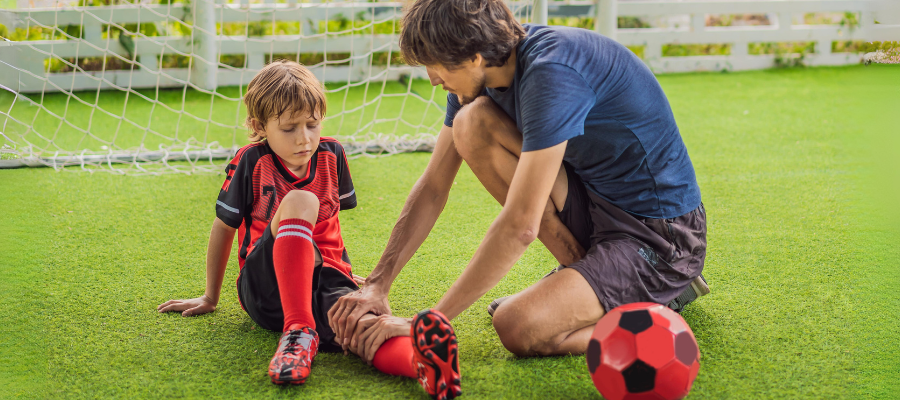In a world where sports play a pivotal role in shaping the physical and mental well-being of our children, the responsibility of ensuring their safety cannot be overstated. As parents, we constantly strive to balance the encouragement of their athletic pursuits with the due diligence required to keep them safe. So the question is: what can parents do to ensure the safety of their child in a sport?
This comprehensive guide delves into the multifaceted approach parents can adopt to safeguard their children in the realm of sports.
How to Keep Your Child Safe?
The Essence of Safety in Sports:
The arena of sports offers a myriad of benefits, ranging from physical fitness and teamwork skills to resilience and discipline. However, with these benefits comes the risk of injuries and accidents. Understanding the nature of these risks is the first step in formulating a robust safety strategy.

Understanding and Mitigating Risks
Recognizing Sport-Specific Hazards:
Each sport presents its unique set of risks. For instance, contact sports like football or hockey inherently carry a higher risk of concussions and physical injuries, whereas sports like gymnastics or swimming might pose risks related to strains or water safety. Familiarize yourself with these sport-specific hazards to be better prepared.
The Crucial Role of Protective Gear:
Investing in high-quality protective gear tailored to your child’s sport is non-negotiable. This includes helmets, shin guards, mouthguards, and appropriate footwear. Regular inspections to ensure that this gear is in optimal condition are equally important.
Promoting a Culture of Safety through Training and Education:
Education extends beyond the child to include coaches and other staff. Ensure that your child’s coaches are certified and trained in first aid and injury prevention. Additionally, educating your child on the importance of safety measures, warm-up exercises, and adhering to rules can play a significant role in preventing injuries.
Proactive Parental Involvement
Choosing the Right Sports Program:
Not all sports programs are created equal. Research and select a program that not only aligns with your child’s interests and abilities but also has a strong emphasis on safety protocols and trained personnel.
Encouraging Physical Preparedness:
Preparing your child’s body for the physical demands of sports is critical. This involves not just sports-specific training, but also general physical fitness, flexibility, and strength conditioning. Encourage regular exercise routines that are age-appropriate and fun.
The Importance of Nutrition and Hydration:
A well-nourished and hydrated body is better equipped to handle the rigors of sports. Emphasize the importance of a balanced diet rich in nutrients and the regular intake of fluids, especially water, to maintain optimal performance and prevent heat-related illnesses.
Advocating for Rest and Recovery:
Overtraining can lead to burnout and injuries. Advocate for a balanced approach to training, which includes adequate rest periods and recovery time. This helps in preventing overuse injuries and keeps your child’s enthusiasm for the sport intact.
Fostering Open Communication:
Creating an environment where your child feels comfortable discussing their experiences, concerns, and any discomfort they might be feeling is crucial. This open line of communication helps in early detection of potential issues and timely intervention.

Monitoring and Responding to Injuries
Understanding Common Injuries and Their Symptoms:
Familiarize yourself with common injuries related to your child's sport, such as sprains, strains, and concussions. Knowing the symptoms can help in early detection and prompt response.
Immediate Response to Injuries:
In case of an injury, the immediate response can make a significant difference. Learn basic first aid and ensure that injuries are assessed by a medical professional as soon as possible. Follow their advice on treatment and recovery.
The Role of Rehabilitation and Return-to-Play:
If your child sustains an injury, proper rehabilitation is key to a full recovery. Work with healthcare professionals to develop a safe and effective return-to-play plan, ensuring your child is physically and mentally ready to resume the sport.
Building a Supportive Sports Environment
Promoting a Positive and Supportive Atmosphere:
Encourage a sports environment that is not just about winning, but also about learning, teamwork, and personal growth. A positive and supportive atmosphere can reduce the pressure on young athletes and prevent them from taking unnecessary risks.
Setting Realistic Expectations:
Help your child set realistic goals and expectations for their sporting endeavors. This helps in reducing stress and anxiety, which can contribute to a safer and more enjoyable sports experience.
Being an Informed and Involved Parent:
Stay informed about the latest developments in youth sports safety, and actively participate in discussions and decisions related to your child's sports activities. Your involvement shows your child that you value their safety and well-being.

Always Be Proactive
As parents, our role in ensuring the safety of our children in sports is multi-dimensional. It involves education, preparation, active involvement, and a commitment to fostering a safe and positive sports environment. By taking these proactive steps, we can help our children enjoy the countless benefits of sports while minimizing risks. Remember, the ultimate goal is to nurture not just skilled athletes, but also healthy and happy individuals who cherish the joys of sports.
Check out SportyBella blogs for more sport related articles.

